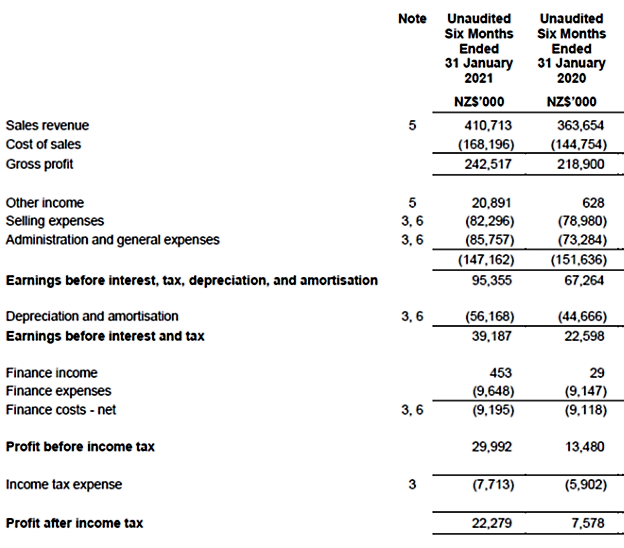The first thing to remember as we review Kathmandu’s half year results is the timing of the Rip Curl acquisition. The acquisition was completed 31 October 2019. It’s included in Kathmandu’s numbers for the full six months of the period ended 31 January 2021 but for only three months during the prior period’s six months. The numbers are in New Zealand dollars, each of which costs about US$ 0.70.
Below are the as reported income statements for both periods for the consolidated company.
Revenue rose 12.9% while the gross profit margin fell from 60.2% to 59.1%. Pretax income was up 82.0%. If it weren’t for covid and the acquisition, you’d say, “Solid result!” and move on.
But as for all companies, the pandemic muddies the waters as does the Rip Curl deal- which I consider to be a solid strategic acquisition.
For the current period, “Other income includes government grants of $20,503,000 (2020: nil) related to wage and other subsidies received in response to the impact of COVID-19…” Without the government grants, all other things being equal, their pretax income would have been lower than in the prior calendar period (pcp). However, things are never equal. If they hadn’t received that money (because there was no covid) revenue would have been higher, and expenses different.
One thing that wouldn’t have been different- the pcp’s expenses include $10.1 million for the acquisition of Rip Curl. Acquisition related expenses for the most recent period are zero.
Kathmandu’s management of expenses was typical of other industry companies. From the conference call: “We continue to be cautious around our operating costs in response to the current uncertain trading conditions. As such, there were some significant restructuring and synergy savings and rent abatements, supplemented by government wage assistance.” In addition to rent abatements, restructuring and synergy savings (the result of buying Rip Curl I assume) were said to annualize at $15 million.
For all industry companies it will be interesting to see which reductions stick, which come back, and what new ones there might be as we adjust to whatever the new normal might turn out to be- a process already ongoing before the pandemic as the retail market evolved.
Next, let’s look at results from the Outdoor and Surf segments. Outdoor includes the Kathmandu and Oboz brands. Surf is Rip Curl.
The pcp was pre pandemic. The most current period was during the pandemic. As with all companies, that difference in the operating environment makes the numbers a bit hard to get a solid perspective on.
The pcp contains only 3 months of Rip Curl revenue, while the most current period includes a full six months. The 86.1% revenue increase for Surf is obviously less than you would have expected without the pandemic. CEO Xavier Simonet tells us in the conference call that “Rip Curl’s wholesale order book is above pre-COVID-19 levels.” That sounds good, but I find it hard to interpret.
Outdoor segment revenues were down 30.2%. The last question in the conference call is basically “That’s a pretty big drop. How come?” The answer isn’t very satisfying. In a perfect world, I’d have been happy if they told us the estimated revenue loss from store closures, how much they got back from ecommerce, and what losses they think were from inventory issues. Maybe that would total to an estimate of the pandemic related decline? They mention a virus related reduction in international travel as one cause of lower revenues.
Putting a major acquisition together with a pandemic definitely complicates interpretation of financial results. I’d feel a little better if the gross margin hadn’t fallen. There’s no explanation for the decline. Mr. Simonet notes in the conference call that, “Rip Curl online sales growth was significantly higher across key markets, registering 107% growth in USA, 47% growth in Australia, and 78% in Europe,” but he’s comparing three months to six months as far as I can tell, so it’s hard to conclude anything from those numbers.
I really can’t tell whether Kathmandu had a good six months or not. I think I’m in my third decade of being amazed by how little information Australian companies have to supply. Anyway, Rip Curl was a good strategic acquisition and due to a capital raise, the balance sheet is solid. We’ll hope for some clarity when the next six month report comes out.


